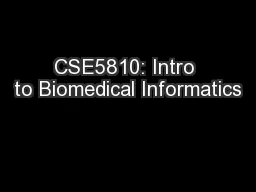PPT-Genome Sciences 373 Genome Informatics
Author : walsh | Published Date : 2024-03-13
Q uiz Section 5 April 28 2015 Bonferroni corrections The motivation is to minimize the probability of a single falsepositive test Type I Error We often define
Presentation Embed Code
Download Presentation
Download Presentation The PPT/PDF document "Genome Sciences 373 Genome Informatics" is the property of its rightful owner. Permission is granted to download and print the materials on this website for personal, non-commercial use only, and to display it on your personal computer provided you do not modify the materials and that you retain all copyright notices contained in the materials. By downloading content from our website, you accept the terms of this agreement.
Genome Sciences 373 Genome Informatics: Transcript
Download Rules Of Document
"Genome Sciences 373 Genome Informatics"The content belongs to its owner. You may download and print it for personal use, without modification, and keep all copyright notices. By downloading, you agree to these terms.
Related Documents














